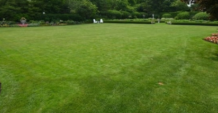 Gardeners love shrubs for a myriad of reasons: their few maintenance needs, their multiple seasons of interest, the habitat and food they may provide for birds, the food they may provide for humans, their versatility in garden design. In response to today’s smaller properties and busy lives, breeders have developed petite varieties of classic shrubs that fit into tighter spaces and need no pruning. These small selections are also a natural fit for container gardening.
Gardeners love shrubs for a myriad of reasons: their few maintenance needs, their multiple seasons of interest, the habitat and food they may provide for birds, the food they may provide for humans, their versatility in garden design. In response to today’s smaller properties and busy lives, breeders have developed petite varieties of classic shrubs that fit into tighter spaces and need no pruning. These small selections are also a natural fit for container gardening.
Paired with the right shrub, a pot can create a long-lasting, even year-round focal point. It can make a simple but strong statement within a garden or mark transition points. If it’s not huge, it can be a movable detail. In a small garden, potted shrubs can act as dividers and privacy screens. In patios, courtyards and balconies where all the plants live in pots, shrubs introduce diversity and scale and provide a natural backdrop for perennials and annuals.
Pots expand the planting possibilities regardless of some local conditions, too. Want to try a shrub not hardy in your zone? Plant it in a pot that you can move under cover in winter. Itching to grow blueberries, camellias or other acid lovers although you garden in alkaline soil? Try them in a pot of tailor-made growing mix.
Points to Consider
When choosing a shrub to grow in a container, go for a species that’s naturally small or a variety that’s been selected for a compact habit. Alternatively, you can choose a shrub that will ultimately grow quite large if you plan to transplant it into a permanent in-ground location within a few years, or if you’d like to try restricting its size through regular root pruning. Whatever shrub you pick, match it to a container that is two to three times the size of the shrub’s nursery pot.
As for growing requirements, there are two key factors to bear in mind. The first is the shrub’s winter hardiness. Choose something rated to two USDA zones colder than your own climate. For example, if you garden in Zone 6, the shrub should be able to withstand winters in Zone 4. If it’s not that hardy, plan to move it into a cold but sheltered space for the winter. The container must be weighed against your climate, too. In cold-winter areas, it should be frost-proof, so that it won’t crack or break as temperatures fluctuate.
The second key consideration is the shrub’s moisture needs. Soil in containers dries out much more quickly than ground soil. You can choose a shrub that loves damp earth, but be prepared to water it perhaps twice a day at the height of summer. Even drought-tolerant potted shrubs will likely need to be watered more than you may expect, especially in hot and windy weather. Make sure any container you choose has adequate drainage holes.
Planting and Care
If you select a large container and shrub, their combined weight will be significant. Put the pot in its final position before adding the soil and shrub. Use a well-draining mix that addresses any special requirements of what you’re growing. The steps for planting are the usual: Set the shrub so that it sits at the same level as it did in its previous container. Water it in well and top off the soil with mulch to conserve moisture and regulate the soil temperature.
A topdressing of compost and application of a slow-release fertilizer each spring will bolster the potting mix in support of the shrub.
Slowed, absent or weak growth are clues that it’s time to repot. Repotting is an opportunity to root prune, which will revitalize the plant while also helping to maintain it in its current container, rather than moving to a larger one. Shrubs that do outgrow the pot can be moved into a bigger vessel or into the ground—freeing up that favorite pot for a new subject entirely.
MEGHAN SHINN www.hortmag.com




